THAILAND
Plants and Animals

Plants and Animals

Cities in THAILAND
| Bangkok |
Plants and Animals
Plants
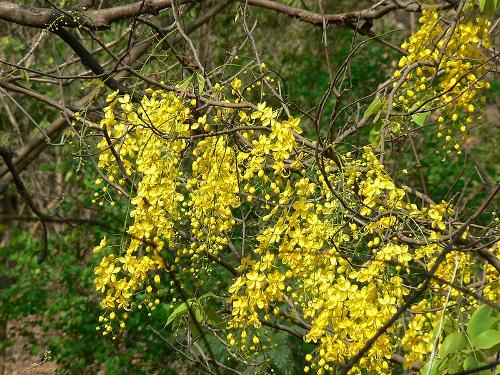 Indian Laburnum, ThailandPhoto: Dinesh Valke CC 2.0 Generic no changes made
Indian Laburnum, ThailandPhoto: Dinesh Valke CC 2.0 Generic no changes made
The variety of plants is great in Thailand due to the elongated shape of the land and the differences in height, and in the north it largely matches those of India and Myanmar (Burma) and in the south it matches Malaysia and Indonesia. It is estimated that six percent of the known types of vascular plants on Earth are found in Thailand. There are approximately 15,000 native vascular plants, including more than 500 tree species and more than 1,000 orchid species. The orchid is therefore considered a national symbol, but the real national tree / flower is the Indian golden rain. Tropical plants, including hibiscus, acacia, lotus, red jasmine, and bougainvillea, abound. Azaleas and rhododendrons bloom in the cooler northern regions.
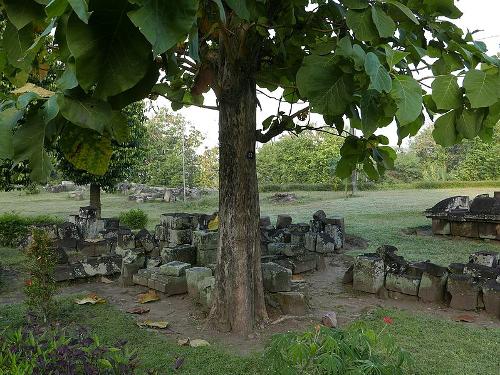 Teak Tree, ThailandPhoto: Photo Dharma CC 2.0 Generic no changes made
Teak Tree, ThailandPhoto: Photo Dharma CC 2.0 Generic no changes made
Originally, the land was largely covered with forests (now about a quarter of the land, about 130,000 km2), from mangrove forests on the coast to coniferous forests ( Pinus) on the mountain tops. Deciduous monsoon forest with oak trees predominates in the north; there are also many teak forests here. Mixed rain forest occurs in the south and on mountain slopes in the north. Parts of southern Thailand are covered with evergreen tropical rainforest. Ironwood, rattan, rosewood and palms grow here, among other things. daeng and the tabaek.
The flora of Phuket's Khao Sok National Park includes lianas, bamboo, rattan, ferns, and the spectacular rafflesia, a giant parasite, with a diameter of 80 centimeters making it the largest flower in the world. It is a parasite with no roots or leaves of its own that proliferates in the roots of a liana. Another biological rarity only seen in Phuket and Khao Sok National Park is the 'Lahng kao', an indigenous species of palm.
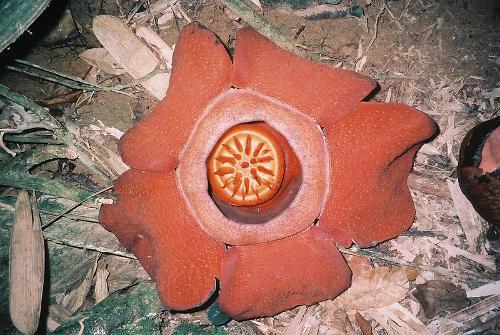 Rafflesia ThailandPhoto: Klaus Polak CC 3.0 Unported no changes made
Rafflesia ThailandPhoto: Klaus Polak CC 3.0 Unported no changes made
Mangrove forests thrive on the coast and mouth of the deltas. Mangrove forests are flood forests in the tropics, where the roots of the trees are in the mud of the seacoast. At low tide the root system is exposed and at high tide it is under water. These forests are still found in Thailand at Chantaburi, Koh Chang, Phuket, Krabi, Trang and Songkla. In thirty years, the area of mangrove forests has been reduced from 3680 km2 to 1650 km2 due to the fact that it produces excellent firewood. Between the roots are the breeding grounds of many fish.
Much of the original vegetation has given way to cultures, savannas (especially in the lowlands of the central plain) and secondary vegetation including many bamboo forests. The main crops are rubber trees, tobacco, sugar cane and cotton. To turn the tide, a ban on logging has been enacted by the Thai government since 1989.
Animals
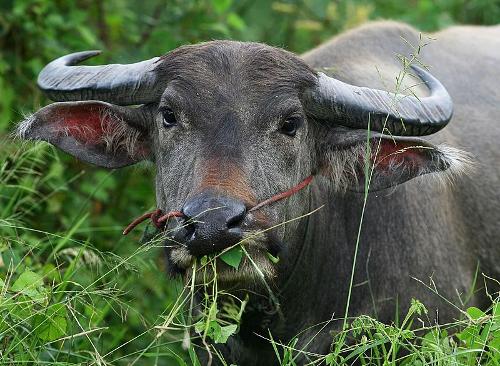 Thai water buffaloPhoto: Heiko S CC 2.0 Generic no changes made
Thai water buffaloPhoto: Heiko S CC 2.0 Generic no changes made
The highly varied animal world of Thailand belongs to the Indo-Chinese zone in the north and the Sunda zone in the south, of which also Malaysia and large parts of Indonesia are part. An extensive transition area runs between these two zones. It is estimated that 10% of fish species, 10% of birds, 5% of reptiles and 3% of amphibians are found in Thailand.
There are about 300 species of mammals, including bantengs, gaurs, bark and dwarf deer, sambar deer, goat antelopes, Malay tapirs, panthers, tigers (only a handful along the Myanmar border), Malay bears, Burmese sun badger, Tibetan black bears, flying lemurs and numerous monkeys (including crested gibbons). The Javan rhinoceros has probably been completely extirpated, as is the kouprey, a wild bovine; the Sumatran rhinoceros may still be found in Thailand.
The Thai water buffalo, slightly smaller than its Indian counterpart, is still an important animal for rural people. It is mainly used for plowing the rice fields and almost everything from the buffalo is used. Water buffalos are also found in China, India, and throughout Southeast Asia.
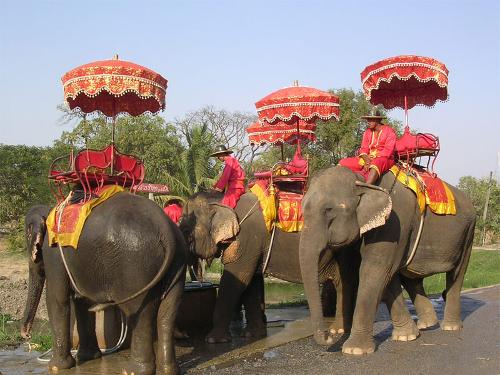 Ayutthaya Elephant Camp in ThailandPhoto: Yosemite CC 3.0 Unported no changes made
Ayutthaya Elephant Camp in ThailandPhoto: Yosemite CC 3.0 Unported no changes made
The Asian elephant is an important symbol for Thailand and used to be indispensable in teak wood production. An adult elephant is about 3 meters high, can weigh up to 4000 kilos and live up to 100 years. There are two types of elephants in Thai culture: the working elephant and the war elephant. About 25,000 of the working elephants are left and an estimated 1,500 elephants are still living in the forests. The bird world is also very rich and has about 1000 species, including the argus pheasant and many water birds in the south. Silversmiths migrate to the Thai swamps to reproduce, marsh purple moths are common and the crested partridges live in the south, in the lowland forests along the coast. The national bird of Thailand is the Siamese fireback pheasant.
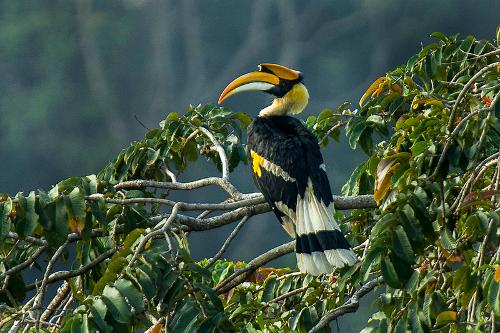 Hornbill ThailandPhoto: Francesco Veronesi CC 2.0 Generic no changes made
Hornbill ThailandPhoto: Francesco Veronesi CC 2.0 Generic no changes made
Northern Thailand is located on the East Asian migration route, an important route for migratory birds. 380 bird species are found around the hills of Chiang Mai alone. Thailand is home to about 10% of all bird species in the world. Northern Thailand is home to, among others, the black-crowned night heron, red wattle plover, silver pheasant, water pheasant, robin parakeet, hawk eagle, purple heron, pheasant spur cuckoo, long-tailed broadbill, Gould's honeybird, Asian paradise flycatcher, red-throated thrush, brown owl, black-necked starling, white-crested bird's-tailed raven and flag-tailed raven. In the Thale Noi Water Bird Park in the deep south of Thailand you can see the marsh fowl, the jassana, the whistle, the white-throated kingfisher, the long-legged ridge i-kong and the rarer white ibis and blue heron. The hornbill is one of the most spectacular birds in Thailand. The double hornbill is most striking with its bright yellow and black feathers.
The serow, an antelope species, is becoming increasingly rare in Northern Thailand; the sambar, the largest Thai deer, lives on the central plains, among other places. Spectacled mangoes are found on the Thai-Malay peninsula. there are three other species of langur in Thailand.
Thailand is also home to many reptiles, including 76 species of snakes, six of which are poisonous. Dangerous are the cobra, the Malayan viper, the krait and the green viper; very dangerous and also veryaggressive are the king cobra and russels pit viper. The river turtle and the Indian crocodile are endangered.
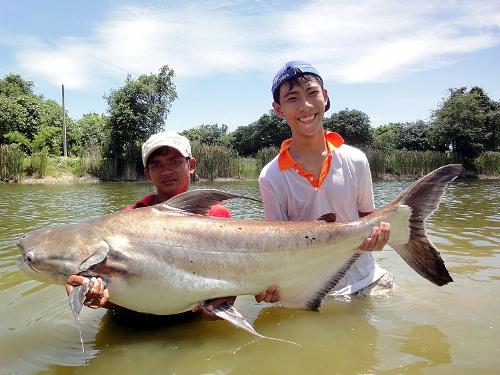 Giant Catfish ThailandPhoto: Gv-fishing CC 3.0 Unported no changes made
Giant Catfish ThailandPhoto: Gv-fishing CC 3.0 Unported no changes made
The estuaries of the rivers and coastal waters are home to dolphins, including the rare Irrawady dolphin. Furthermore, we fish for blue marlin, sailfish, barracuda and various types of sharks. In the Mekong River enters the endangered giant catfish; even before, the largest freshwater fish in the world. Two-meter-long specimens weighing around 300 kilograms have already been caught.
The Siamese (Thailand used to be called Siam), a cat species that has spread all over the world.
 Siamese catPhoto: Dan Taylor CC 2.5 no change made
Siamese catPhoto: Dan Taylor CC 2.5 no change made
Lizards and geckos occur in great numbers. Thailand also has hundreds of species of butterflies, including the imposing Atlas butterfly, the largest butterfly species in the world.
The ecosystem on Thailand's highest mountain, the Doi Inthanon, belongs to the sub-Himalaya system. It is possible to see rare animals there, such as flying squirrels, red-toothed shrews, Chinese pangolins and Davids field mice. This protected area is also rich in birdlife, such as blue-winged minlas, green cochas, red-headed trogons and green-tailed honeybirds.
Thailand's most beautiful coral reefs are in the Andaman Sea. They consist of innumerable sea creatures and grow very slowly: one meter in 1000 years. Thousands of plants and animals live around these coral reefs, including gobies, clown triggerfish, moray eels, leopard sharks, giant mantas, snappers and large hermit crabs. The underwater fauna around Phi Phi (Island of the Spirits) is beautiful with special shark species such as the smooth shark, blackfin reef shark and blacktip shark.
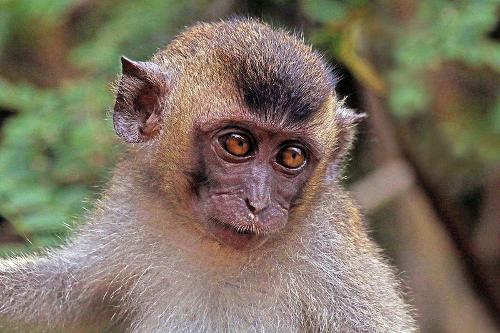 Macaque ThailandPhoto: Charles J Sharp CC 4.0 International no changes made
Macaque ThailandPhoto: Charles J Sharp CC 4.0 International no changes made
Mangrove forests are in the south of Thailand, especially in Phang-nga Bay. In this ecosystem spawn, breed, eat crustaceans, fish, birds, snakes and even mammals; it is also an excellent hiding place. Mudhoppers, dwarf otters, crabs, macaques, the black and yellow water snake Boiga dendrophia and rare sea crocodiles live here.
The dugong (sea cow) was in danger of extinction in Thai waters. Now their numbers are slowly increasing again. The area around the Andaman Islands of Trang is one of the few places where they can be seen. They eat sea grass that grows near Ko Libong and the Trang estuary. They reach a length of three meters and a weight of about 400 kilos.
The Lawa Cave in Sai Yok National Park is one of 21 caves in Kanchana Buri province home to the kitti bat or Craseonycteris thonglongyai . It is the smallest mammal in the world, no bigger than a butterfly and weighing only two grams. There are only about 2000 specimens left, making it one of the most endangered species in the world. The creature was not discovered by a Thai biologist until 1973.
Khao Sam Roi Yot National Park is home to the rare liangpha, an Asian mountain goat.
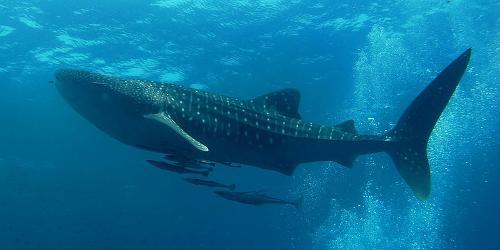 Whale Shark Siliman Islands, ThailandPhoto: Abe Phao Lak CC 4.0 no changes made
Whale Shark Siliman Islands, ThailandPhoto: Abe Phao Lak CC 4.0 no changes made
The Similan Islands are true islands for nature lovers. Whale sharks, manta rays, bottlenose dolphins and large deep-sea fish can be seen in the waters around the islands. More than 30 bird species such as the white-breasted moorhen and the Brahminy hawk nest on the islands and there are also migratory birds such as the egret, pintail snipe, gray wagtail and Dougal's tern. Furthermore, small mammals such as porcupine, common palm civet and flying lemur. Many reptiles and amphibians also come in all shapes and sizes, including venomous ringkraits, pythons, white-lipped and common pit vipers, leather and hawksbill turtles, and Bengal and common water dragons.
The country is relatively sparsely populated, whereby the greatest concentration is also located on the coast. Still, clearing of the forest, animal trade and poorly regulated hunting have caused much damage. Nowadays more attention is paid to nature protection, which comes under the forest management department; since 1961, adequate protection has existed here and there in a number of national parks. Thailand now has about 80 national parks, including 19 marine reserves. Approx. 15% of the land area is protected area. The first park was Khao Yai in Central Thailand with an area of more than 2000 km2. The largest natural park is Kaeng Krachan, southeast of Bangkok.
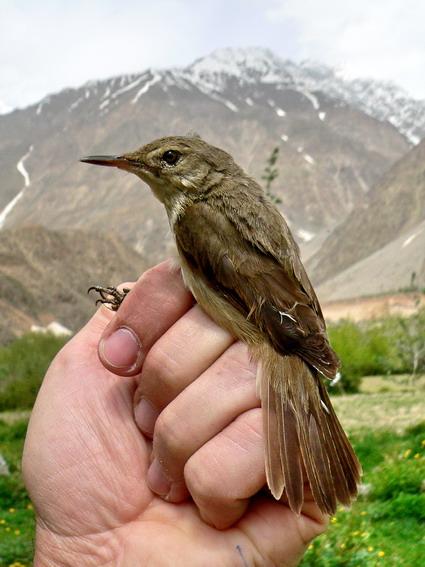 Humes reed warbler occurs again in ThailandPhoto: Pavel Kvartalnov CC 3.0 Unported no changes made
Humes reed warbler occurs again in ThailandPhoto: Pavel Kvartalnov CC 3.0 Unported no changes made
Ornithologists accidentally discovered the Humes reed warbler in 2006 near Bangkok, a bird species thought to be extinct for 139 years. A specimen of this swamp and songbird was last captured in North India in 1867.
Sources
Clutterbuck, M. / Thailand
Van Reemst
Davies, B. / Thailand
Kosmos-Z&K3
Forbes, A. / Thailand
Kosmos-Z&K
Hahn, W. / Thailand
Van Reemst
Hauser, S. / Thailand : mensen, politiek, economie, cultuur, milieu
Koninklijk Instituut voor de Tropen
Hoskin, J. / Thailand
Van Reemst
Macdonald, P. / Thailand
Kosmos-Z&K
Miethig, M. / Thailand
Lannoo
Peterse, L. / Thailand
Gottmer/Becht
Steinmetz, P. / Thailand
Elmar
Thailand
Uitgeversmaatschappij The Reader’s Digest
Thailand
Lannoo
CIA - World Factbook
BBC - Country Profiles
Copyright: Team The World of Info